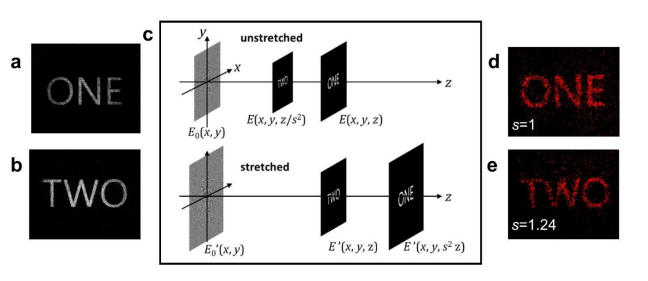First Stretchable Holographic Display Unveiled

One of the great advances in materials sciences in recent years has been the development of metamaterials and metasurfaces with optical properties that are not found in nature. These materials contain repeating elements that interact with electromagnetic waves to reflect, bend, and distort light.
In this way, researchers have built materials with negative refractive index, super-resolution lenses, and even invisibility cloaks. The same kind of tricks are possible with reflective surfaces too. Researchers have made metasurfaces that act as flat lenses, vortex beam generators, and even as computer-generated holograms.
And that raises an interesting question—just how much further can materials scientists take this technology?
Today we find out thanks to the work of Stephanie Malek and pals at the University of Pennsylvania in Philadelphia. They’ve printed a hologram onto a metasurface and shown how it changes as the film is stretched. The work points the way toward a new kind of display that switches the information it displays as it stretches.
Metasurfaces are simple in theory. The idea is that an array of tiny conducting rods can influence the way light reflects off them. By spatially varying the orientation of the rods, it is possible to create patterns in the reflected light. From there, it is a straightforward computer calculation to work out how to arrange the conducting rods to create a hologram.
The first task is to create an array of gold nanorods and embed them in a flexible film, in this case a kind of contact lens-like polymer called PDMA. Malek and co do this by covering a silicon wafer with plastic and then using photolithography to carve out the desired pattern.
They then coat the remaining plastic with gold and then pour PDMA on to the surface so it forms a layer that covers the gold rods and fills the gaps in between.
Finally, the team peels off this PDMA layer, taking the gold nanorods with it. The result is a thin layer of PDMA containing gold nanorods in the pattern that creates the desired hologram.
Malek and co go a little further by creating a hologram containing two or more images that appear at different distances from the surface. They then show that stretching the layer changes the distance between the nanorods, enlarging the holograms and changing their distance from the film.
That creates an interesting effect. Anybody viewing the hologram from a specific distance sees the first hologram morph into the second and then back again as the film is stretched and relaxed. “Upon stretching, these devices can switch the displayed holographic image between multiple distinct images,” say Malek and co.
The team has tested the idea with a number of holograms that display a “one” followed by a “two,” a circle followed by a square followed by a triangle, and so on.
And that suggests the technology could be used for an entirely new kind of display. “Stretchable metasurface holograms may prove useful for applications such as virtual reality, flat displays, and optical communication,” say Malek and co, who have already demonstrated a stretchable metasurface that works as a zoom lens, increasing magnification by 1.7 times as it is stretched.
Looks like metasurfaces are finally close to the commercial world. We’ll be interested to see how this and other developments appear on the market.
Ref: arxiv.org/abs/1702.03810: Strain Multiplexed Metasurface Holograms on a Stretchable Substrate
Keep Reading
Most Popular
Large language models can do jaw-dropping things. But nobody knows exactly why.
And that's a problem. Figuring it out is one of the biggest scientific puzzles of our time and a crucial step towards controlling more powerful future models.
How scientists traced a mysterious covid case back to six toilets
When wastewater surveillance turns into a hunt for a single infected individual, the ethics get tricky.
The problem with plug-in hybrids? Their drivers.
Plug-in hybrids are often sold as a transition to EVs, but new data from Europe shows we’re still underestimating the emissions they produce.
Stay connected
Get the latest updates from
MIT Technology Review
Discover special offers, top stories, upcoming events, and more.